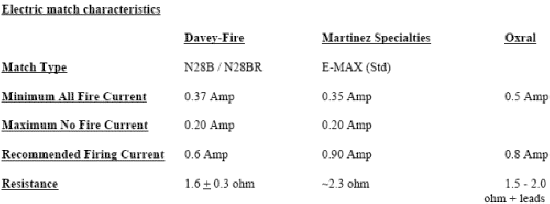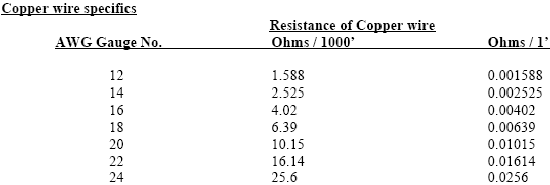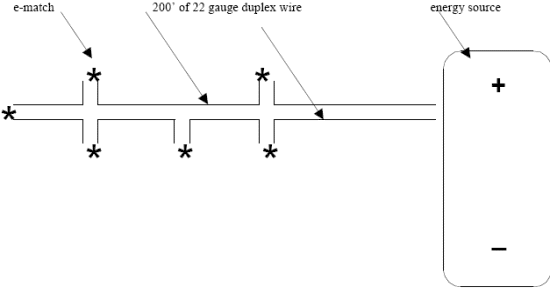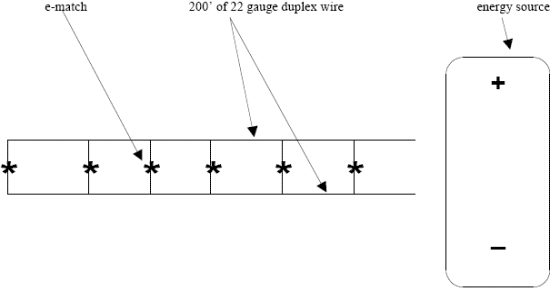| Electric firing allows the pyrotechnician the ability to fire single or multiple pyrotechnic devices in a more precise manner from a remote location. Obviously this adds an element of safety when firing large caliber shells, as well as adds a wider range of firing options such as large "fronts" or choreography of large scale displays or pyromusicals. While electric firing has greatly enhanced the type and complexity of displays that pyrotechnicians can perform, it has also added new risks and complexities which need to be understood. Hopefully this information will provide you with a basic level of knowledge from which each pyrotechnician can learn and add to as they progress through their career in the fireworks industry.
1 Basics Electric Match --is the basic initiator utilized in electric firing of pyrotechnic devices. It consists of two lead wires connected by a fine bridgewire which is coated with a pyrotechnic composition similar to a match head. When a given current (usually 1 amp, or greater) is applied across the leads, the bridgewire heats up and the e-match head is ignited, thereby igniting the device. The e-match may have a protective HDPE / plastic shroud covering the head which is removable. Often they are mistakenly called "squibs", which are actually an electric match boosted with an extra charge (such as blackpowder). These are also different from an electric blasting cap which not only utilizes a basic electric match assembly, but also uses a pyrotechnic delay and or primer charge which in turn initiates a high explosive charge encased in an aluminum shell--utilized to initiate / detonate primary high explosives. Neither of these find much use in the pyrotechnic industry and are also highly regulated.
Connecting Wire --is the wire used to connect the electric match to the energy source to complete a circuit. It may be the commonly used "duplex" wire typically ranging from 20 to 24 gauge, or it could be a single conductor, coupled with a common ground or "bus" wire. In the blasting industry the above duplex wires are often connected to a main heavier gauge re-usable "firing line" used to initiate the charge from hundreds of feet away. Also complex firing cables consisting of many fine 24 -26 gauge conductors are utilized in conjunction with computer like connectors to attach firing boxes or slats to main firing consoles or computer systems.
Energy Source --provides the necessary current to fire the electric matches in the circuit. Dry Cells --not used frequently alone (often they are the source of initial energy for CD firing) "Wet" Cells --like car batteries, are used by many to power firing systems, often linked together in series to provide "more power" to a firing circuit. They are usually rechargeable.
Generators --such as 10 cap military twist type blasting machines, or push down (hell box) type generators (often 50 -100 cap design). Both of which are capable of mechanically generating a short burst of electric current to fire a given circuit.
Capacitor Discharge Blasting/ Firing machines --utilize dry cell batteries ranging from as little as 3V to 9V to charge capacitors and "step up" and store several hundreds of volts to be released all at once into a circuit to fire large numbers of e-matches all at once.
Electronic Firing Panels / Systems --utilize many circuits / switches, which are then connected to multiple firing conductor cables and firing boxes / slats. These are often powered by large rechargeable batteries. Many different brands of firing systems are available, some are also computer controlled. All of which are used to fire complex large scale fireworks displays.
2 Safety First Safety is of the utmost concern when dealing with any type of explosives. While electric firing eventually affords the pyrotechnician with the luxury of remote firing, thereby reducing the possible harm of an unplanned malfunction, it does carry with it some inherent additional risks. Most of the risk is associated with the actual e-match, its installation and potential for accidental firing. Below are a list of things to consider and remember when utilizing electric firing.
Electric matches are "match heads" and are friction sensitive and can be ignited by simply pulling it out of a quickmatch leader and having its head rub against the rough bare match.
Electric matches are impact sensitive. Rough handling resulting in an unplanned impact such as stepping on an e-matched leader, or dropping a large shell with the e-match installed in the lift could ignite the match.
Electric matches are static sensitive. Static charges are more prevalent in low humidity conditions, and significant charges can be generated by snow and dust storms. Electric matches generally have higher resistance bridgewires than many blasting caps and also do not have any internal feature to prevent electrostatic energy from accidentally initiating the igniter / detonator such as all modern electric blasting caps have. Shunting of the lead wires of the e-match and circuit provide some protection from static charges.
Electric matches are sensitive to atmospheric DC energy sources such as lightning. Shunting of e-matches provides little if any protection from a nearby ground strike. A lightning strike could produce a million volt potential with 100,000 amp discharge current thereby firing part or all of the electric matches in its vicinity whether they are shunted or not. However all leads and circuits should be shunted during a lightning storm and all personnel should be evacuated to a safe distance. Although commercial lightning detection equipment is available and will warn of approaching lightning storms well in advance of the storm, many blasters use a poorly tuned AM radio. The presence of static noises on the radio indicate static charges (lightning) in the air.
Electric matches are sensitive to stray currents from poorly grounded or insulated electrical equipment or leaking power sources. Electric firing in the vicinity of overhead or nearby power lines can be a hazard not only from a leaking power source, but the potential exists for a firing line to be propelled by a pyrotechnic device up over a live high voltage power line resulting in electrocution of the pyrotechnician. Shunting of the e-match leads and circuits is helpful and protective against stray currents.
Electric matches are sensitive to induced currents such as those produced by alternating electromagnetic fields which exist in the vicinity of high voltage power lines, transformers, etc. These can in turn induce a current directly into a completed electric blasting / firing circuit. Some protection is provided by the shunted e-match / circuit.
Electric matches are radio frequency sensitive. Intense radio frequency (RF) can fire an e-match. AM broadcast transmitters appear to have more potential to do this. Also FM, UHF TV transmitters, CB radios, radar / microwave transmitters even possibly cellular phones and handheld transmitters have a potential to fire an e-match. While shunting of e-matches and circuits is always recommended, it probably does not provide any significant protection. Handheld portable low power ultra high frequency radio transmitters(" walkie talkies") have been used with great success around electric pyrotechnic circuits for many years, but care should be exercised.
Never hook up a power source to your electric circuit while still working in the vicinity. Only attach a power source when ready to fire. Keep arming keys out of electric firing panels until ready to arm.
Be aware of other potential power sources with exposed contact points.
3 Specifics

** When making calculations, most pyrotechnicians allow for a 1 amp firing current (series) and assume approx. 2 ohm resistance / match
** Only use the same type & brand of e-match in the same circuit --failure to do so, could result in erratic firing
Copper wire specifics Resistance of Copper wire AWG Gauge No. Ohms / 1000' Ohms / 1'

** measured at 68 degrees Fahrenheit
** Remember, when calculating circuit resistance to account for duplex wire (i.e., double the calculated resistance, since two strands are being used)
Wiring Circuits

It is important to understand this basic law, and how to use it. This becomes especially important when you have long fronts of pyrotechnic devices you wish to fire simultaneously, as you need to know if your energy source is capable of delivering enough energy to reliably fire all the electric matches.
4 Series Wiring Series wiring connects each electric match to your connecting wire in such a fashion that current flows from one match to the next( like "old fashioned Christmas lights"). This is the most commonly used type of wiring in both the pyrotechnic and blasting industry. It is simple to do, and utilizes less firing energy than parallel wiring. Furthermore, it is easy to test the circuit to see if the calculated resistance is equal to the actual measured resistance thereby insuring a more reliable chance of successful firing. Mistakes are also easier to find. The only rare problem with series firing is that if even one electric match or connection is faulty, the entire series of electric matches will fail to ignite, but that is why we ALWAYS TEST our completed circuits.

Resistance Calculation (for above series circuit): Resistance is calculated by simply adding up the total resistance of all the electric matches in the circuit, plus adding in the resistance of the connecting wire.
Resistance of one electric match 2 ohms Resistance of 6 electric matches (6 x 2 ohms) 12 ohms Resistance of 200' of 22 gauge duplex wire (0.016 ohms x 200' x 2 strands wire) 6.4 ohms Total resistance 18.4 ohms
Voltage Calculation (for above series circuit): V = I x R V = 1 amp x 18.4 ohms Thus V = 18.4 volts (thus an ordinary 12 volt car battery would not have enough energy to reliably fire this circuit)
*Remember to use 1amp recommended firing current for series match circuits*
5 Parallel Wiring Parallel wiring essentially connects each electric match lead to the energy source (similar to most "house wiring"). Parallel wiring requires much more firing energy, and it is very difficult to test the circuit. However if one match or connection fails, others may ignite. This wiring has also failed because insufficient firing energy has resulted in the firing of the first few matches downstream from the energy source which in turn have lead to fusion of the bridgewire resulting in a "short" circuit. This may prevent any current passing further and thus failing to ignite the remaining electric matches down stream.

Resistance Calculations (parallel wiring) Resistance is calculated by taking the resistance of 1 electric match and dividing it by the total number of electric matches in the parallel circuit, and adding this value to the resistance of the connecting wire.
Resistance of one electric match 2 ohms
Resistance of 6 electric matches in parallel ( 2 ohms / 6 matches) 0.33 ohms
Resistance of 200' of 22 gauge duplex wire ( 0.016 x 200' x 2 strands wire) 6.4 ohms
Total resistance 6.73 ohms
Voltage Calculations (parallel wiring) V = I x R V = 6 amps x 6.73 ohms Thus V = 40.38 volts (obviously this type of wiring requires more energy to fire the same number of electric matches over the same lengths of connecting wire)
*Remember 1 amp firing current is required for each electric match in the parallel circuit*
Series-Parallel Wiring Utilizes several individual series of electric matches, connected in parallel to the connecting wire. While this has been used in the blasting industry, it finds very little use in the pyrotechnic display industry.
6 Testing Testing is the key to insuring success for the firing of a given circuit. While e-matches are generally made under strict quality control, occasionally a "dud" will occur. It is best to test each match with a Blasting Galvanometer, Blasting Ohmmeter, or a Blasting Multimeter to see if its resistance is similar to what the rated resistance for that e-match. No reading of resistance (no needle deflection or measured reading), means a faulty match with a break in the leads, solder connection, or broken bridgewire and it should not be used. A resistance very close to zero most likely means a "short" in the leads, and it should not be used. Similarly an e-match with an overly high resistance may be faulty and should not be used. Only matches which read similar in resistance to what they are rated for by the manufacturer should be used.
The series circuit should be checked with the Blasting Galvanometer, to see if the measured resistance is similar to the calculated resistance for a given circuit. A close to zero reading means a "short" in the circuit somewhere (This can be isolated by using the galvanometer to check resistance between various points in the circuit). A very high resistance reading could signal poor connections, or a faulty bridgewire. If the measured reading comes in very close to the calculated resistance than you can be reassured that the circuit will fire with a very high degree of certainty (given that the proper energy to fire that given circuit is applied).
Use of ohmmeters not specifically designed for the pyrotechnic or blasting industries places the pyrotechnician in a position of high risk, secondary to possible accidental firing of the device! Blasting Galvanometers and the like are specifically designed to be incapable of firing any electric match, squib or blasting cap. This is not so for standard multimeters in use in the electrical trade, especially those of older analog design which may produce currents close to the minimum firing current of a given match. Some experts in the pyrotechnic trade have measured some commercial digital multimeters and feel that some which produce less than 50 milliamps of current are safe to test e-matches and circuits. I feel it is worth the extra expense to use only certified blasting grade galvanometers for testing, as you only have to be wrong once! In many states it is illegal to test a blasting cap /circuit with anything other than a blasting galvanometer / multimeter (including Pennsylvania, although this does not specifically apply to the pyrotechnic industry, but rather the high explosive blasting industry--we certainly could take a lesson from them.)
Also there are some rather inexpensive pyrotechnic / blasting continuity testers available but they only check for continuity (not true resistance), thus you can not tell a "short" from a normal resistance.
*Remember to have all personnel removed from the firing area when testing electric circuits / e-matches.
7 Connections & Installation of E-matches Connections Making the proper connections means everything in electric firing; failure to do so can mean failure of a desired often time consuming large scale effect. While any tight strong wire connection will work (twisting, wire nuts, taping, crimping), the time tested most efficient, strong and proven method is the "Twisted Loop". This method used almost exclusively in the blasting industry is virtually fail-safe, super strong, low resistance and very quick. Simply the two "stripped" conductors (wires) are placed side by side, both folded over at half their length into a loop and then the whole loop is twisted upon itself. Many people then tape these connections to "insulate" them (this is especially important when several connections may come in contact with each other potentially creating a "short" -also this is important when working around metal structures like steel bridgework / decks). While other just twist the actual connections along the connecting wire in opposite directions to keep them apart and isolate them, thus effectively "insulating" them.
Installation of the electric match For aerial shells, the e-match may be inserted directly into the lift charge, with emphasis on making sure the e-match is actually in the lift charge, not between the lift bag and outer paper wrap. Some e-match manufacturers will not sell e-matches without a shroud if they are to be installed this way. This way of installing the e-match allows for much more precise timing and firing of the shell. It also is felt by some to be more dangerous to handle( i. e.., if dropped you have the weight of the shell impacting on the e-match head potentially causing a catastrophic firing), also it is more difficult to deal with a misfire.
Aerial shells may also have their e-matches installed into the quick match leader, by simply cutting a slit in the quickmatch, gently sliding the match in along the bare blackmatch within, taking care to do this gently and make sure the e-match is in direct contact with the black match inside. Depending on the diameter of the quick match outer piping this can be difficult with the shroud in place, but the shroud is there for a reason. This form of installation is perhaps a bit safer to handle, as the shell can be e-matched while in the mortar, with the pyrotechnician beside not over the mortar installing the e-match.
If pyrotechnic devices other than aerial shells have a quickmatch leader, e-matches can be installed in a similar fashion. If a visco type fuse is used by the device in question, a sure fire way to connect the e-match to the visco fuse, is to first cut a short length of quickmatch, insert the visco fuse into the quickmatch paper piping against the bare match and then do the same with the actual e-match, then tape the whole assembly securely to the device. I have never seen this system fail.
Whatever way you attach the e-match to the device, make sure the lead wires of the e-match are then secured to the mortar, rack, etc.--so as upon firing to prevent them from being "ripped" from the circuit or firing box / slat which could damage the circuit or expensive firing equipment. This will also help prevent someone from accidentally pulling apart your circuit, and potentially prevent an accidental firing of a device by the friction / ignition of an e-match being ripped out of a quickmatch.
References: ISEE (17 th Edition) Blaster's Handbook; Daveyfire, E-Max , Oxral & Seminole Wire product specification sheets.
|